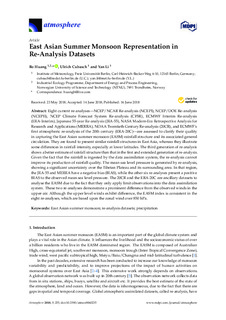| dc.contributor.author | Huang, Bo | |
| dc.contributor.author | Cubasch, Ulrich | |
| dc.contributor.author | Li, Yan | |
| dc.date.accessioned | 2019-09-05T11:51:08Z | |
| dc.date.available | 2019-09-05T11:51:08Z | |
| dc.date.created | 2018-11-22T18:31:34Z | |
| dc.date.issued | 2018 | |
| dc.identifier.citation | Atmosphere. 2018, 9 (6), 1-17. | nb_NO |
| dc.identifier.issn | 2073-4433 | |
| dc.identifier.uri | http://hdl.handle.net/11250/2612666 | |
| dc.description.abstract | Eight current re-analyses—NCEP/NCAR Re-analysis (NCEPI), NCEP/DOE Re-analysis (NCEPII), NCEP Climate Forecast System Re-analysis (CFSR), ECMWF Interim Re-analysis (ERA-Interim), Japanese 55-year Re-analysis (JRA-55), NASA Modern-Era Retrospective Analysis for Research and Applications (MERRA), NOAA Twentieth Century Re-analysis (20CR), and ECMWF’s first atmospheric re-analysis of the 20th century (ERA-20C)—are assessed to clarify their quality in capturing the East Asian summer monsoon (EASM) rainfall structure and its associated general circulation. They are found to present similar rainfall structures in East Asia, whereas they illustrate some differences in rainfall intensity, especially at lower latitudes. The third generation of re-analysis shows a better estimate of rainfall structure than that in the first and extended generation of re-analysis. Given the fact that the rainfall is ingested by the data assimilation system, the re-analysis cannot improve its production of rainfall quality. The mean sea level pressure is generated by re-analysis, showing a significant uncertainty over the Tibetan Plateau and its surrounding area. In that region, the JRA-55 and MERRA have a negative bias (BIAS), while the other six re-analyses present a positive BIAS to the observed mean sea level pressure. The 20CR and the ERA-20C are ancillary datasets to analyse the EASM due to the fact that they only apply limit observations into the data assimilation system. These two re-analyses demonstrate a prominent difference from the observed winds in the upper-air. Although the upper level winds exhibit difference, the EASM index is consistent in the eight re-analyses, which are based upon the zonal wind over 850 hPa. | nb_NO |
| dc.language.iso | eng | nb_NO |
| dc.publisher | MDPI | nb_NO |
| dc.rights | Navngivelse 4.0 Internasjonal | * |
| dc.rights.uri | http://creativecommons.org/licenses/by/4.0/deed.no | * |
| dc.title | East Asian Summer Monsoon Representation in Re-Analysis Datasets | nb_NO |
| dc.type | Journal article | nb_NO |
| dc.type | Peer reviewed | nb_NO |
| dc.description.version | publishedVersion | nb_NO |
| dc.source.pagenumber | 1-17 | nb_NO |
| dc.source.volume | 9 | nb_NO |
| dc.source.journal | Atmosphere | nb_NO |
| dc.source.issue | 6 | nb_NO |
| dc.identifier.doi | 10.3390/atmos9060235 | |
| dc.identifier.cristin | 1633986 | |
| dc.description.localcode | © 2018 by the authors. Licensee MDPI, Basel, Switzerland. This article is an open access article distributed under the terms and conditions of the Creative Commons Attribution (CC BY) license (http://creativecommons.org/licenses/by/4.0/). | nb_NO |
| cristin.unitcode | 194,64,25,0 | |
| cristin.unitname | Institutt for energi- og prosessteknikk | |
| cristin.ispublished | true | |
| cristin.fulltext | original | |
| cristin.qualitycode | 1 | |

